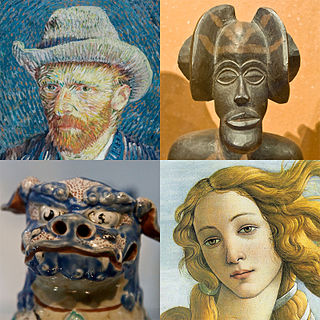
Art is a diverse range of human activity, and its resulting product, that involves creative or imaginative talent generally expressive of technical proficiency, beauty, emotional power, or conceptual ideas.

Aesthetics is the branch of philosophy concerned with the nature of beauty and the nature of taste; and functions as the philosophy of art. Aesthetics examines the philosophy of aesthetic value, which is determined by critical judgements of artistic taste; thus, the function of aesthetics is the "critical reflection on art, culture and nature".

Bharatanatyam is an Indian classical dance form that originated in Tamil Nadu. It is one of eight Indian classical dance forms recognized by the Sangeet Natak Akademi, and expresses South Indian religious themes and spiritual ideas, particularly of Shaivism and in general of Hinduism.

Body language is a type of communication in which physical behaviors, as opposed to words, are used to express or convey information. Such behavior includes facial expressions, body posture, gestures, eye movement, touch and the use of space. The term body language is usually applied in regard to people but may also be applied to animals. The study of body language is also known as kinesics. Although body language is an important part of communication, most of it happens without conscious awareness.

Indian classical dance, or Shastriya Nritya, is an umbrella term for different regionally-specific Indian classical dance traditions, rooted in predominantly Hindu musical theatre performance, the theory and practice of which can be traced to the Sanskrit text Natya Shastra. The number of Indian classical dance styles ranges from eight to twelve, or more, depending on the source and scholar; the main organisation for Indian arts preservation, the Sangeet Natak Academy, recognizes eight – Bharatanatyam, Kathak, Kuchipudi, Odissi, Kathakali, Sattriya, Manipuri and Mohiniyattam. Additionally, the Indian Ministry of Culture includes Chhau in its list, recognising nine total styles. Scholars such as Drid Williams add Chhau, Yakshagana and Bhagavata Mela to the list. Each dance tradition originates and comes from a different state and/or region of India; for example, Bharatanatyam is from Tamil Nadu in the south of India, Odissi is from the east coast state of Odisha, and Manipuri is from the northeastern state of Manipur. The music associated with these different dance performances consists many compositions in Hindi, Malayalam, Meitei (Manipuri), Sanskrit, Tamil, Odia, Telugu, and many other Indian-Subcontinent languages; they represent a unity of core ideas, and a diversity of styles, costumes and expression.
In music cognition and musical analysis, the study of melodic expectation considers the engagement of the brain's predictive mechanisms in response to music. For example, if the ascending musical partial octave "do-re-mi-fa-sol-la-ti-..." is heard, listeners familiar with Western music will have a strong expectation to hear or provide one more note, "do", to complete the octave.

Music appreciation is a division of musicology that is designed to teach students how to understand and describe the contexts and creative processes involved in music composition.
Jerrold Levinson is distinguished university professor of philosophy at the University of Maryland, College Park. He is particularly noted for his work on the aesthetics of music, as well as for his search for meaning and ontology in film, art and humour.
In control theory, affect control theory proposes that individuals maintain affective meanings through their actions and interpretations of events. The activity of social institutions occurs through maintenance of culturally based affective meanings.
Art as Experience (1934) is John Dewey's major writing on aesthetics, originally delivered as the first William James Lecture at Harvard (1932). Dewey's aesthetics have been found useful in a number of disciplines, including new media.
Display rules are a social group or culture's informal norms that distinguish how one should express themselves. They can be described as culturally prescribed rules that people learn early on in their lives by interactions and socializations with other people. They learn these cultural standards at a young age which determine when one would express certain emotions, where and to what extent.
Applied aesthetics is the application of the branch of philosophy of aesthetics to cultural constructs. In a variety of fields, artifacts are created that have both practical functionality and aesthetic affectation. In some cases, aesthetics is primary, and in others, functionality is primary. At best, the two needs are synergistic, in which "beauty" makes an artifact work better, or in which more functional artifacts are appreciated as aesthetically pleasing. This achievement of form and function, of art and science, of beauty and usefulness, is the primary goal of design, in all of its domains.
Indian art evolved with an emphasis on inducing special spiritual or philosophical states in the audience, or with representing them symbolically.

Research into music and emotion seeks to understand the psychological relationship between human affect and music. The field, a branch of music psychology, covers numerous areas of study, including the nature of emotional reactions to music, how characteristics of the listener may determine which emotions are felt, and which components of a musical composition or performance may elicit certain reactions.
In psychology of art, the relationship between art and emotion has newly been the subject of extensive study thanks to the intervention of esteemed art historian Alexander Nemerov. Emotional or aesthetic responses to art have previously been viewed as basic stimulus response, but new theories and research have suggested that these experiences are more complex and able to be studied experimentally. Emotional responses are often regarded as the keystone to experiencing art, and the creation of an emotional experience has been argued as the purpose of artistic expression. Research has shown that the neurological underpinnings of perceiving art differ from those used in standard object recognition. Instead, brain regions involved in the experience of emotion and goal setting show activation when viewing art.
A theory of art is intended to contrast with a definition of art. Traditionally, definitions are composed of necessary and sufficient conditions and a single counterexample overthrows such a definition. Theorizing about art, on the other hand, is analogous to a theory of a natural phenomenon like gravity. In fact, the intent behind a theory of art is to treat art as a natural phenomenon that should be investigated like any other. The question of whether one can speak of a theory of art without employing a concept of art is also discussed below.
Expressive suppression is defined as the intentional reduction of the facial expression of an emotion. It is a component of emotion regulation.
Jenefer Mary Robinson is an American philosopher, author and emerita professor of philosophy at the University of Cincinnati. She writes on aesthetics, philosophy of psychology, philosophy of mind and theory of emotions. She has published two monographs, one edited collection, and numerous peer reviewed articles. She is on the editorial Board for the Journal of Aesthetics and Art Criticism and was on the editorial board for Notre Dame Philosophical Reviews. She was president of the American Society of Aesthetics from 2009 until 2013. In 2007 she was a Leverhulme visiting professor of philosophy at the University of Nottingham and in 2006 she received a Rieveschl Award for Scholarly and/or Creative Works. She received the National Endowment for the Humanities Fellowship in September 2002. She was interviewed by Hans Maes for his book Conversations on Art and Aesthetics, which also contains her portrait by American photographer Steve Pyke. Debates in Aesthetics, an open access journal published by the British Society of Aesthetics, dedicated Vol. 14 No. 1 to her work.
Spatiality is term used in architecture for characteristics that, looked at from a certain aspect, define the quality of a space. In comparison to the term spaciousness, which includes formal, dimensional determination of size—depth, width or height—spatiality is a higher category term. It includes not only formal, but other qualities of space—such as definition, openness, visibility, expressivity, etc.
Carolyn Ingrid Saarni was a developmental psychologist known for groundbreaking research on children's development of emotional competence and emotional self-regulation, and the role of parental influence in emotional socialization. She was a professor in the Department of Counseling at Sonoma State University from 1980 to 2013.







